Presidential Dollars gone wrong
The United Stated Mint began issuing the Presidential Dollars in February of 2007, and the program will continue until every
deceased U.S. President has been honored. Because it goes against U.S. tradition (not to mention U.S. law) to depict a living
person on the Legal Tender, ex-presidents can only be honored after they have passed away for at least two years. The
Presidential Dollar program, as stated in the legislaton that created it, is scheduled to end in the first quarter of 2016 with
Richard M. Nixon. However, it is expected that Ronald Reagan and Gerald Ford will be included, and possibly George Bush, Sr.,
(born 1924.) The front side of each coin depicts the image of a former President and his years served in office. The reverse
shows a view of the Statue of Liberty that is common to all presidential dollar coins, along with the inscriptions "The United
States of America" and "$1."
The Presidential Dollas program was inagurated with George Washington's bust appearing on the first issue, however an
unknown number of the new coins were mistakenly struck without their edge inscriptions, including "In God We Trust". They made
it past inspectors and went into circulation on February 15, 2007, fetching some $50 on ebay. The properly struck dollar coins
are inscribed along the edge with "In God We Trust," "E Pluribus Unum" , along with the year and mint mark. The U.S. Mint
struck 300 million George Washington dollars, which are golden in color and slightly larger and thicker than a quarter. About
half were made in Philadelphia and the rest in Denver.
It is unknown how many coins lack the proper inscriptions. Ron Guth, president of Professional Coin Grading Service, said he
believes that at least 50,000 error coins were put in circulation. The frenzy over this hugely significant error started a few
days after the error caught the attention of the media. The first specimen (manufactured in the Denver Mint and found in
Chicago) closed for $612 on eBay, while at least one additional coin was sold for a $200 Buy-It-Now price. Dozens of
listings appeared in a matter of days with bids topping out around $80.
How to Tell if a Godless Plain Edge Dollar is Fake
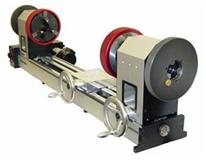
It took little time for unscrupulous people to take advantage of the 'Godless Dollars', by removing the edge lettering and
presenting the 'regular' Presidential Dollars as rarities. The edge lettering inscription is often removed by an electric
device called a dremel, which is a hand-held tool that looks roughly like a electric screwdriver, and which has various
interchangeable heads on the top that spin. Some of these heads have the ability to grind the metal off the edge of a coin.
Alternatively, one can use a lathe, which is a heavy duty piece of equipment often found in metalworking shops. A lathe is sort
of like a drum or wheel that turns at high speed, and it can strip a quarter millimeter of metal off of a coin's edge in a
matter of seconds.
Following the application of the dremel or lathe, a buffing step is used, to hide the tell-tale marks of stripping off
metal. Because coin collectors have been referring to these faked plain edge dollars as having "buffed off" edges, fake plain
edge dollars have been nicknamed "Buffy Dollars."
How to Check For a Fake Plain Edge Dollar
In order to make sure that you Plain Edge "Godless Dollar" is not fake, you need first to observe the exact weight and
diameter of the coin. Genuine, unmodified Presidential Dollars should weigh 8.1 grams (125 grains) +/- 3 grains and have a
diameter of 1.043 inches, (about 26.49 mm) +/- 0.003 inch (0.076 mm). Since most people do not have the proper equipment to
measure such small weights and lengths, you could use a maginfying glass (preferably 10x) to examine the edges of the coin.
As a general rule, the edges on the Presidential Dollars are a mess under good magnification, with dings, dents and other
non-letter markings, along with faint vertical lines. If all you see is a smooth, nearly perfect edge, that is bad news.
Presidential Dollars Programs
The presidential coin set is modeled after the popular 50 State Quarter Program created by Congress in 1997. That program
has attracted many new individuals to the coin collecting hobby, while renewing interest in our nation's history and the
contribution of each state. What's more, Uncle Sam has enjoyed a profit of $0.20 or so for every quarter released into
circulation, reflecting the difference between the cost of producing the coin and its face value in commerce, bringing in more
than $4 billion extra dollars to the Treasury due to the public demand for State Quarters.
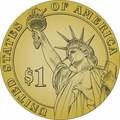
Presidential Dollars Reverse Type - Artist Rendering |
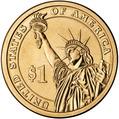
Statue of Liberty Reverse of the Presidential Dollar as Struck for Circulation |
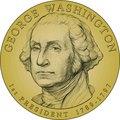
George Washington Presidential Dollar Coin Artist Rendering |
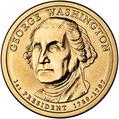
George Washington's Presidential Dollar as Struck for Circulation |
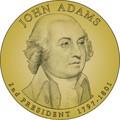
John Adams Presidential Dollar Coin Artist Rendering |
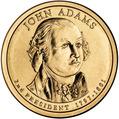
John Adams's Presidential Dollar as Struck for Circulation |
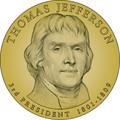
Thomas Jefferson Presidential Dollar Coin Artist Rendering |
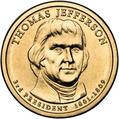
Thomas Jefferson's Presidential Dollar as Struck for Circulation |
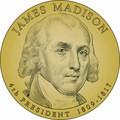
James Madison Presidential Dollar Coin Artist Rendering |
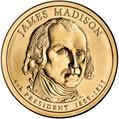
James Madison's Presidential Dollar as Struck for Circulation |

Presidential Dollars Incused Edge Inscriptions Artist Rendering |

The Edge Lettering of the Presidential Dollar as Struck for Circulation |
The issuance dates for the first 38 presidential dollar coins are certain, carrying us until the year 2016. How many new
presidential coins are minted beyond that is dependent on the number of living former presidents who die prior to 2014. Jimmy
Carter and George H.W. both turn 90 that year. Bill Clinton and George W. Bush, both born in 1946, would be 68 in 2014, so the
odds are good they won't qualify for their presidential coins by then.